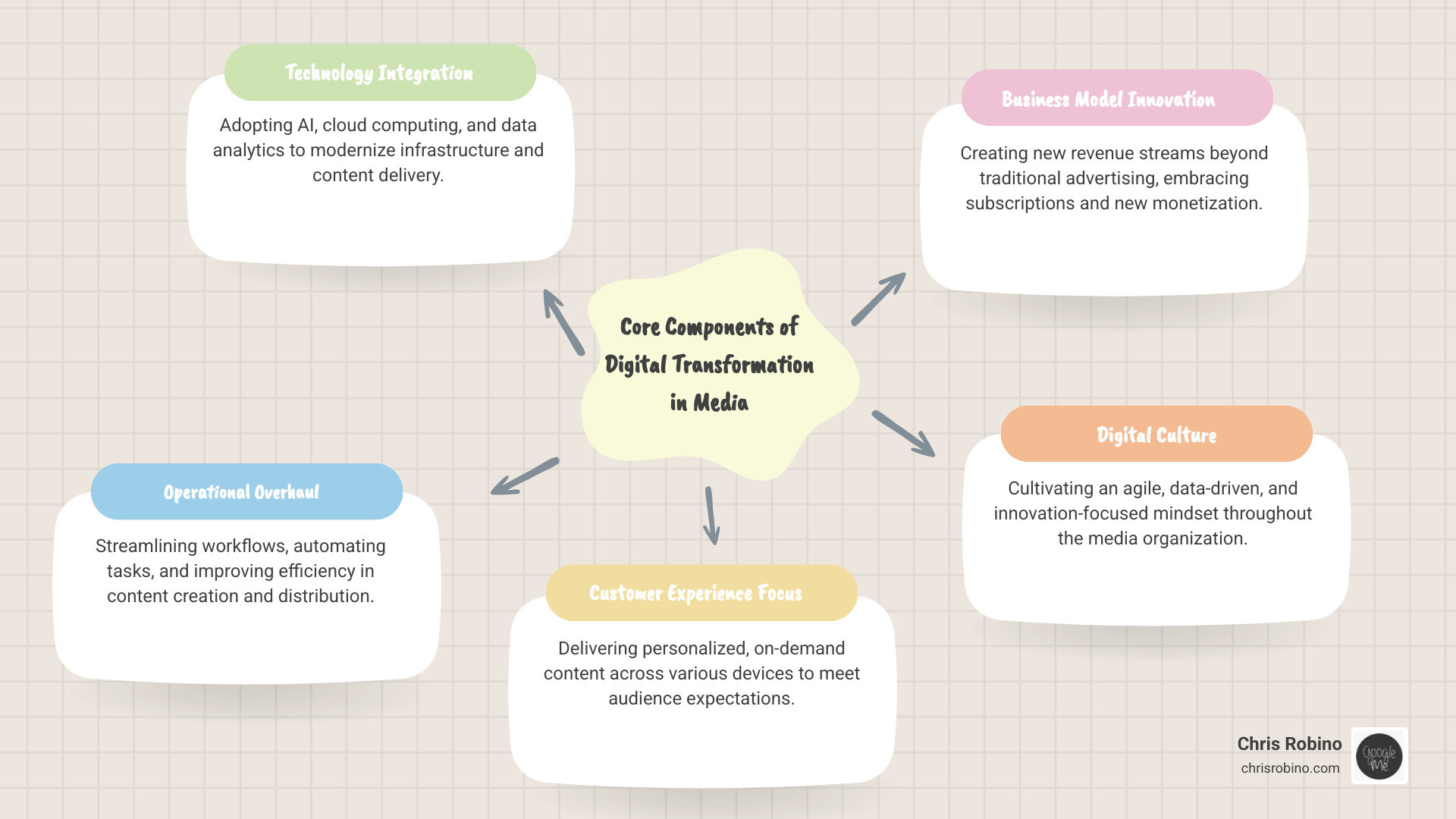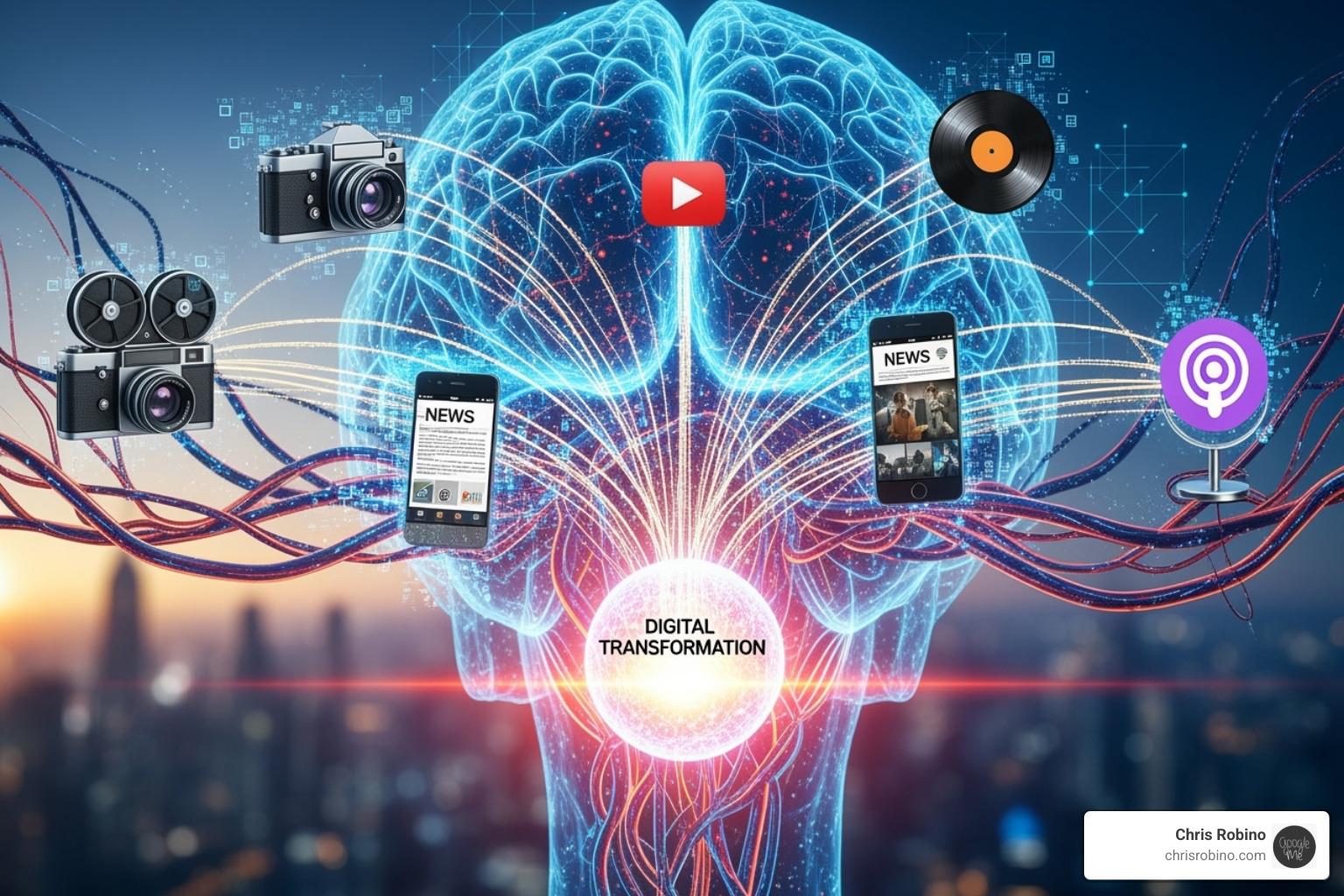The Digital Revolution in Media: Understanding Digital Change
The media industry is facing a profound shift. Digital change for media is the integration of digital technology into all areas of a media business. This fundamentally changes how content is created, distributed, consumed, and monetized. It’s about rethinking traditional business models and enhancing user experience.
Here’s what digital change in media primarily involves:
- Technology Integration: Adopting new tools like AI, cloud computing, and data analytics.
- Operational Overhaul: Streamlining workflows, improving efficiency, and automating tasks.
- Customer Experience Focus: Delivering personalized, on-demand content across various devices.
- Business Model Innovation: Creating new revenue streams beyond traditional advertising.
The change is no longer just “on the horizon”—it’s already here. Audiences now expect high-quality content, available instantly, across all their devices. This puts immense pressure on media companies to modernize and adapt. Those that don’t risk being left behind.
I’m Chris Robino, and my two decades of experience in digital strategy have focused on helping organizations harness innovative technology and strategic digital initiatives to maximize ROI, particularly through successful digital change for media endeavors. My aim is to help you steer this complex landscape, turning today’s challenges into tomorrow’s successes.

Why Digital Reinvention is No Longer Optional
The media and entertainment industry is undergoing a profound shift, driven by growing consumer demand for digital experiences. Why is this reinvention so critical? Simply put, the way people consume content has changed dramatically. Today’s consumers want instant access to high-quality content across multiple devices. This means that the industry faces intense pressure to modernize.
The most evident change is the decline of traditional cable. Nearly 50 million Americans have completely cut the cord on cable, a trend that highlights a massive shift in audience behavior. The streaming revolution, fueled by mobile and cloud technologies, has ushered in an era where audiences expect on-demand, personalized, and mobile-first content. The mass audience of yesteryear has been replaced by a mosaic of highly fragmented audiences, each with unique preferences. This shift from a one-to-many broadcast model to a personalized one-to-one experience means that media companies must adapt or risk becoming obsolete.

Understanding the Key Drivers for Digital Change for Media
Several key drivers are compelling media and entertainment organizations to undergo digital change for media:
- Changing Consumer Behavior: As mentioned, audiences now demand content on their terms—on any device, at any time. This has led to the rise of Over-The-Top (OTT) platforms and a preference for personalized experiences.
- Democratization of Content: User-generated content platforms have empowered individuals to become content creators, leading to a vibrant creator economy. This fundamentally shifts content production from traditional hubs to a broader, more diverse “creator-sphere.”
- Shift in Advertising Spend: Digital video ads have already surpassed traditional TV, with over 66% of global investment flowing to major digital platforms. Digital advertising, especially on mobile and connected TVs, is surging, with an anticipated 9.5% annual growth. This means ad dollars follow eyeballs, compelling media companies to build robust digital presences.
- Data-Driven Audience Insights: Digital platforms provide unprecedented access to data, allowing companies to understand audience behavior and preferences more accurately. Leveraging this audience data is crucial for improving engagement and optimizing content strategies.
- New Revenue Models: Digital innovation has changed business models and revenue streams. The ability to quickly scale operations and adapt strategies is a key advantage of digital change for media, enabling companies to explore diverse monetization opportunities beyond traditional advertising.
Overcoming the Problems: Common Challenges and Barriers
While the necessity of digital change for media is clear, the journey is not without its problems. Media companies often encounter significant challenges and barriers:
- Technological Barriers: Integrating new technologies with existing legacy systems can be complex and costly. Legacy systems for creating content are often insufficient for the demands of the digital age, and maintaining outdated technologies can be more expensive than investing in new ones.
- Organizational Resistance: Fear of the unknown, job security concerns, and cultural inertia can lead to significant organizational resistance. Implementing digital change requires a shift in mindset, and people and organizations often fear and resist change.
- Financial Constraints: The high implementation and maintenance costs of new digital infrastructure and tools can be a significant barrier. Careful planning and prioritization of investments are essential for long-term gains.
- Cybersecurity Threats: As media companies move more of their operations and content online, protecting intellectual property and sensitive customer data becomes a top priority. Robust cybersecurity measures are critical.
- Talent Gaps: There’s often a lack of relevant digital, data, and multimedia skills within traditional media organizations. Upskilling existing staff and attracting new talent are vital for success.
- Data Silos: Information often resides in disparate systems, making it difficult to gain a holistic view of audience behavior or operational efficiency. Breaking down these silos is crucial for effective data utilization.
The journey from traditional media to a digital-first approach is complex, requiring not just technological adoption but a deep organizational and cultural shift. As we explore in depth at Moving From Ops System To Browser Based To The Clouds, overcoming these internal obstacles is as critical as embracing new technologies.
Core Strategies for Successful Digital Change for Media
Successfully implementing digital change for media requires a strategic, holistic approach. It’s not just about buying new software; it’s about fundamentally changing how we operate, think, and deliver value to our audiences.
The reality is that many media companies approach digital change like they’re renovating a house room by room. But what they really need is to build a new foundation entirely. This means embracing a digital-first culture where innovation isn’t just encouraged—it’s embedded in every decision we make.

The first step is securing leadership buy-in. Without executives who truly understand and champion digital change, even the best strategies will fail. Leaders need to model the behavior they want to see, whether that’s adopting new collaboration tools or making data-driven decisions part of their daily routine.
Next comes implementing agile methodologies across the organization. Traditional media operates on long production cycles, but digital audiences expect content that responds to trends in real-time. Agile approaches allow teams to test, learn, and iterate quickly—turning what used to be months-long projects into week-long sprints.
Data governance is equally crucial. Without proper systems for collecting, storing, and analyzing information, companies are essentially flying blind. This ties directly into fostering Innovation In Media Companies, where data becomes the fuel for creative decision-making.
Building a Tech-Forward Foundation
A robust technological infrastructure is the backbone of any successful digital change for media. Think of it as laying the groundwork for everything else you want to accomplish.
Cloud infrastructure has become non-negotiable for modern media companies. It enables streamlined production workflows, secure content management, and improved accessibility for teams working from multiple locations. The cloud’s operational expense model also aligns costs with revenue, making it particularly attractive as distribution becomes more fragmented. Companies exploring this transition often benefit from understanding Cloud Based Computing fundamentals.
For media companies, delivering high-quality video at scale requires Enterprise Content Delivery Network (eCDN) solutions. These systems ensure smooth, high-definition content delivery with minimal buffering—because nothing kills audience engagement faster than a spinning loading wheel.
As media companies shift toward direct-to-consumer models, subscription management software becomes crucial for streamlined billing, customer lifecycle management, and optimizing recurring revenue. The subscription economy rewards companies that make it easy for customers to start, modify, and maintain their relationships with your content.
Automating workflows across content creation, distribution, and back-end business operations significantly reduces operational costs while increasing efficiency. From automated social media posting to AI-assisted video editing, the goal is freeing up human creativity for higher-value tasks. This often connects to broader Information Technology Consulting Services that help organizations identify the best automation opportunities.
Leveraging Data for Audience Growth and Monetization
Data truly is the new oil in the media industry. Effective digital change for media hinges on our ability to collect, analyze, and act upon audience insights in ways that feel helpful rather than invasive.
Building a first-party data strategy means collecting information directly from your audience through subscriptions, account registrations, and engagement tracking. This proprietary data is invaluable for understanding behaviors, preferences, and lifetime value—and it’s becoming more crucial as third-party cookies disappear.
Audience segmentation allows us to move beyond the old “spray and pray” approach to content distribution. By understanding who our readers and viewers actually are, we can deliver personalized content recommendations based on individual choices, browsing history, and demographic data. Media companies using AI for customer personalization can achieve revenue boosts of up to 15%.
Data analytics transforms raw numbers into actionable insights. Companies that excel at using audience engagement data drive higher recirculation, increased time on site, and improved visit frequency. This directly impacts both advertising revenue and subscription retention rates.
This data strategy also plays a crucial role in improving Search Engine Rankings. When we understand what our audience actually wants, we can create content that both serves their needs and performs well in search results.
Key metrics we should track for measuring digital audience engagement include time on site or app (indicating content engagement), pages per session (showing consumption depth), return visit rate (measuring loyalty), content shares and interactions (reflecting resonance), conversion rates for subscriptions or ad clicks (direct monetization measurement), and audience demographics (informing targeting strategies).
SEO Strategies for Large Media Companies
For large media organizations, search engine optimization is not a siloed technical task but a strategic imperative woven into the fabric of digital change for media. It directly influences audience findy, engagement, and revenue generation. Success at scale hinges on a multi-faceted approach that addresses the unique challenges of massive content libraries and high-traffic platforms.
First, a robust technical foundation is non-negotiable. This involves optimizing site architecture for crawlability and scalability, ensuring that search engines can efficiently find and index millions of pages. Managing crawl budgets, eliminating duplicate content, and ensuring lightning-fast load times across all devices are critical. A focus on Core Web Vitals and mobile-first performance is essential, as user experience is a primary ranking factor.
Second, content strategy must be deliberate and data-informed. This means creating high-quality, evergreen content that serves as a long-term asset, consistently attracting organic traffic and valuable backlinks. Equally important is the practice of regularly auditing and updating legacy content to maintain its relevance and accuracy. By utilizing advanced analytics and first-party data, media companies can identify content gaps, understand user intent, and deliver personalized experiences that deepen engagement—a strong positive signal to search engines.
Finally, authority and context are key differentiators. Implementing structured data and schema markup helps search engines understand the context of articles, videos, and events, increasing the likelihood of appearing in rich results like news carousels. A smart internal linking strategy is also vital for distributing page authority throughout the site, guiding users to relevant content, and signaling the importance of cornerstone pages to search algorithms.
The Tangible Impact: Revenue, Operations, and Audience Experience
When media companies accept digital change for media, the results speak for themselves. We’re not just talking about flashy new technology—we’re talking about real, measurable improvements that hit the bottom line and transform how audiences experience content.

The most exciting part? Digital change for media opens up entirely new ways to make money. Gone are the days when advertising was the only game in town. Today’s successful media companies are diversifying with subscription models that create predictable recurring revenue, pay-per-view options for premium content, and sophisticated programmatic advertising that delivers the right message to the right person at exactly the right moment.
The numbers tell an encouraging story. Industry analysts estimate the Entertainment & Media industry will grow to US$3.4 trillion by 2028, with digital advertising leading the charge at an impressive 9.5% annual growth rate. That’s not just growth—that’s a fundamental shift in where the money flows.
But revenue is only part of the equation. The real magic happens when we improve the customer experience. Today’s audiences don’t just want content; they want it personalized, accessible, and seamlessly delivered across every device they own. Studies show that getting personalization right can significantly boost revenue—and getting it wrong can hurt just as much.
Think about it: when someone opens your app or visits your website, they’re not just consuming content. They’re having an experience that either builds loyalty or sends them to a competitor. Digital change for media enables us to deliver those custom experiences that keep audiences coming back.
Behind the scenes, operational efficiency improvements are equally impressive. Cloud migration alone can slash operational costs by nearly 40% while boosting application performance by the same margin. That’s the kind of win-win that makes CFOs smile and creative teams more productive.
Case Study: The Shift to Digital Subscriptions
Let me share a success story that perfectly illustrates the power of digital change for media. One prominent legacy news organization didn’t just survive the digital revolution—it thrived by embracing it completely.
Its journey to over 8 million subscribers across digital and print platforms wasn’t accidental. It required a fundamental shift in thinking, treating readers not just as an audience, but as valued customers worthy of a premium experience. It invested heavily in high-quality journalism, built robust digital platforms, and created direct relationships with its audience.
This change demonstrates something crucial: when you focus on delivering genuine value and building direct connections with your audience, people are willing to pay for quality content. It’s a powerful reminder that digital change for media isn’t about chasing the latest trend—it’s about understanding what your audience truly values.
Optimizing for Digital-First Operations
True digital change for media means rethinking everything from the ground up. It’s about creating operations that are designed for today’s digital landscape, not retrofitted from yesterday’s analog world.
Streamlining content supply chains becomes possible when you leverage cloud-based platforms that enable seamless collaboration from creation to distribution. Teams can work together in real-time, whether they’re in the same building or scattered across different continents. This isn’t just convenient—it’s essential for staying competitive in a fast-moving industry.
Remote collaboration tools have evolved from nice-to-have features to business necessities. Cloud-based platforms improve accessibility for teams working from multiple locations, enabling the kind of seamless remote collaboration that keeps content flowing regardless of where your talent is located.
The real efficiency gains come from automating manual tasks that used to eat up valuable human resources. Robotic Process Automation (RPA) handles the repetitive work, freeing up your creative talent for the strategic thinking and innovative content creation that actually moves the needle.
Reducing operational costs isn’t just about cutting expenses—it’s about investing smartly in technology that scales with your business. Modern cloud-based financial management and procurement tools contribute significantly to cost reduction while improving accuracy and speed. As we explore in our Cloud Solutions For Media insights, these solutions help achieve performance results that are sustainable and scalable.
The bottom line? Digital change for media delivers results you can measure, from healthier profit margins to happier audiences to more efficient operations. It’s not just about keeping up with change—it’s about getting ahead of it.
Navigating the Future: Emerging Tech and Trends
The future of digital change for media is dynamic, shaped by rapidly evolving technologies. Staying ahead means understanding and strategically integrating these emerging trends.

- Generative AI in Content Creation: AI tools can assist in scriptwriting, video editing, and graphics creation, speeding up production and reducing costs. Generative AI is ready to revolutionize how content is produced, from automating workflows to generating personalized content recommendations.
- Immersive Experiences (VR/AR): Virtual and Augmented Reality are set to become more mainstream, enabling new forms of immersive storytelling and interactive entertainment. Augmented reality can be used in sports broadcasts to display real-time statistics and visual effects, changing the viewing experience.
- Shoppable TV: The lines between content consumption and commerce are blurring. We anticipate that 2025 will be the year of shopping on TV, with major retailers investing heavily in making content directly shoppable.
- Blockchain for Rights Management: Blockchain is a decentralized, secure database that can track ownership of digital assets. It’s ideal for combating piracy in the media industry, ensuring transparent compensation for creators, and supporting new monetization models through NFTs and tokens. The Blockchain in Media, Advertising, and Entertainment Market is projected for substantial growth in the coming years.
We continuously monitor these shifts, providing up-to-date insights on Emerging Tech Insights.
The Future of Digital Change for Media: AI, VR, and Beyond
The ongoing digital change for media will be increasingly driven by advanced technologies:
- AI-Driven Hyper-Personalization: AI and Machine Learning (ML) will continue to refine content recommendations, ad targeting, and audience insights, allowing for unprecedented levels of personalization. Media companies using AI for customer personalization can achieve significant revenue boosts.
- Virtual and Augmented Reality (VR/AR): While still nascent, VR and AR are becoming more accessible and affordable. They promise to transform content consumption into deeply immersive experiences, from virtual concerts to interactive narratives.
- 5G Connectivity: The widespread adoption of 5G will enable seamless, high-definition content streaming with minimized buffering, enhancing mobile entertainment and expanding global reach.
- Advanced Data Analytics: Big data and analytics will become even more sophisticated, allowing media companies to gain deeper audience insights and optimize content strategies in real-time.
- Robotic Process Automation (RPA): RPA will continue to streamline internal operations, automating repetitive tasks and improving overall efficiency.
For 2024, analysts predict that enterprise spending on generative AI will grow by 30%, signaling the rapid integration of these technologies across industries. As we detail in our AI Driven Business Solutions and our broader Tech Industry Report, the strategic adoption of these innovations will be crucial for media companies to maintain their competitive edge.
Frequently Asked Questions about Digital Change in Media
What is the first step a media company should take in its digital change journey?
It’s easy to feel overwhelmed when thinking about digital change for media. It can seem like a massive mountain to climb! But remember what the wise philosopher Laozi once said: “A journey of a thousand miles begins with a single step.” For media companies, that crucial first step isn’t about buying new software or hiring a huge tech team.
Instead, it’s all about clarity and vision. The very first thing you should do is develop a clear vision and strategy. This means really looking at where you are right now digitally. Where do you excel? Where do you need to grow? It also means truly understanding your audience’s evolving needs and what they expect from you in this digital world.
Finally, and perhaps most importantly, you need to secure leadership buy-in. When the leaders of your organization are fully on board and championing this change, it creates a powerful ripple effect throughout the entire company. Without a clear goal and strong internal support, even the best efforts can fall flat. We need a vibrant picture of what future success looks like, covering everything from content and marketing to how we operate and connect with our people.
How does digital change affect Search Engine Optimization (SEO) for media companies?
Digital change for media isn’t just a buzzword; it fundamentally transforms how we think about SEO. It shifts SEO from being just a technical “to-do list” to a core part of our business strategy. Why? Because now, media companies can use their own first-party data to create content that is incredibly relevant and personal to their audience.
When your content truly meets what users are looking for – their “user intent” – it naturally leads to better engagement. People spend more time on your site, read more articles, and come back more often. These are all positive signals that search engines notice, which in turn helps boost your Search Engine Optimization performance. For instance, knowing what your readers like allows you to deliver custom content that keeps them hooked.
Even with new AI-powered search features like AI Overviews, ranking high organically still means your content is more likely to be featured or cited. So, the core principle remains: creating outstanding, valuable content that truly serves your audience is still the most powerful SEO strategy. It’s about being the most helpful, trustworthy, and authoritative source out there.
How can traditional media companies compete with digital-native startups?
It might seem like a David and Goliath story, but traditional media companies have some incredible strengths that digital-native startups often lack. You have established brand trust, extensive content archives built over years, and deep journalistic expertise that’s truly invaluable. These are powerful assets!
To compete effectively, traditional companies need to leverage these strengths while also embracing agile, digital-first processes. Think about the example of a major legacy newspaper that successfully grew to 8 million subscribers across digital and print. Its journey shows that it’s possible for traditional media to reinvent itself.
This means investing in modern technology, like cloud solutions and advanced content management systems. It also requires fostering a culture of continuous innovation and being open to new ideas. Embracing data-driven decision-making helps you understand your audience better and adapt faster. The key is to modernize your content workflows using data and AI, be present wherever your audience is (even if it means collaborating with newer digital platforms), and truly accept innovation as a constant part of your business.
Conclusion
Phew! What a journey we’ve been on together, exploring the incredible shifts happening in the media world. As we wrap things up, it’s clear that digital change for media isn’t just a fleeting trend or a one-and-done project. Think of it more like a living, breathing evolution – constantly adapting, constantly growing.
The media industry has truly transformed, hasn’t it? We’ve moved from the comforting rustle of print newspapers and the familiar hum of broadcast TV to a vibrant, busy digital landscape. It’s a world where content lives everywhere, from your pocket to your living room screen, always ready when you are.
So, how do media companies not just survive, but truly thrive in this exciting new era? It really boils down to a few core ideas. It’s about embracing a digital-first culture, where innovation is baked into everything you do. It means truly leveraging data-driven insights to understand your audience like never before, giving them exactly what they crave. And of course, it’s about courageously investing in emerging technologies, staying curious about what’s next around the corner.
By doing all this, media companies aren’t just reacting to change; they’re actively steering this fantastic shift from print to pixels. They’re building a foundation that’s not just resilient for today, but future-ready for all the exciting tomorrows. This path requires a bit of courage, a lot of smart thinking, and a genuine commitment to always keep learning and adapting.
Ready to confidently steer this complex, ever-changing media landscape? Want to make sure your strategies are perfectly optimized for success? Then you’re in the right place! Explore the expert guidance offered by Chris Robino to truly optimize your digital life and business operations. Let’s build something amazing together!
